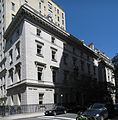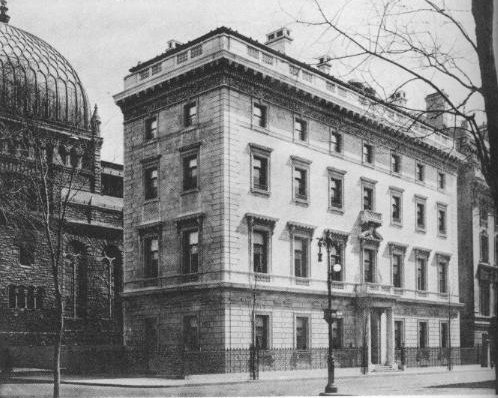Edward Stephen Harkness (January 22, 1874 â€" January 29, 1940) was an American philanthropist.
In 1918, Harkness was ranked the 6th-richest person in the United States by Forbes magazine's first "Rich List", behind John D. Rockefeller, Henry Clay Frick, Andrew Carnegie, George Fisher Baker, and William Rockefeller.
§Biography

Harkness was born in Cleveland, Ohio, one of four sons of Stephen V. Harkness, a harness-maker who invested in and was one of the five founding partners in the forerunner of Standard Oil, John D. Rockefeller's oil company. Edward inherited a fortune from his father and his brother Charles W. Harkness. His extensive philanthropies, many of them anonymous, were extended especially to colleges, hospitals, and museums.
Harkness attended St. Paul's School and Yale University, Class of 1897 and Columbia Law School. Harkness and his brother Charles and cousin William were members of Wolf's Head Society at Yale.
After graduating, Edward Harkness married Mary Stillman, daughter of wealthy New York attorney Thomas E. Stillman. Mary's maternal grandfather was George Greenman, a shipbuilder in Mystic, Connecticut, who founded George Greenman & Co.
Harkness made charitable gifts totaling more than $129 million, the equivalent of $2 billion in 2005 dollars. His philanthropic peers John D. Rockefeller and Andrew Carnegie gave respectively $550 million and $350 million.
Harkness and his mother, Anna Harkness, gave substantial sums to several important non-profit enterprises. They refashioned Columbia-Presbyterian Hospital. Mrs. Harkness, in memory of her husband, gave funds for the hospital's Harkness Pavilion. Harkness was a major benefactor of the New York Public Library and the Metropolitan Museum of Art. In addition to donations to the Decorative Arts Department, The Museum's initial art of Ancient Egypt collection was a gift from Harkness. He bought the complete Tomb of Perneb for the Met and helped purchase the Carnarvon Collection of Egyptian artifacts. He also donated the Met's unofficial mascot, a blue decorative hippo dated back to the Egyptian Middle Kingdom 12, is known as "William".
When Charles died in 1916, he left Edward about $170 million in Standard Oil stock, making Edward the third-largest stockholder. In 1917, Anna Harkness donated $3 million to Yale University to build Harkness Memorial Quadrangle in Charles' memory.
In 1918, Anna Harkness established the Commonwealth Fund with an initial gift of $10 million, and Harkness was made its president. Edward's home, Harkness House ( New York City around 1908 at 5th Avenue and 1 East 75th Street (three blocks from Mary's childhood home at 9 East 78th Street) is now the offices of the Commonwealth Fund. This home, as well as many other Harkness buildings, was designed by Harkness' fellow Yale graduate James Gamble Rogers.
Edward and Mary Harkness had a number of homes in addition to Harkness House in New York. They spent summers at their Eolia mansion on Long Island Sound in Waterford, Connecticut, near where Mary had visited her grandparents in the summers. The home and 230 acres (93Â ha) of gardens and grounds are now maintained by Connecticut as Harkness Memorial State Park. They also owned another house on Long Island in Manhasset, New York on 186 acres called Weekend, designed by architect James Gamble Rogers, plus houses in North Carolina and California, and a camp in the Adirondacks. They also spent time at Yeamans Hall outside of Charleston, SC - another James Gamble Rogers golf and winter community.
The Harkness family made many contributions to education, including St Salvator's Hall at the University of St Andrews; Harkness Chapel and Harkness Dormitory at Connecticut College; Butler Library at Columbia University as well as the original portions of the Columbia University Medical Center and the undergraduate dormitories at Brown University, Harvard University, Yale University, and Connecticut College - all of these were built through his philanthropy or the philanthropy of Mary Stillman Harkness.
His philanthropy affected several boarding schools, introducing the revolutionary Harkness table method of instruction, starting with Phillips Exeter Academy, and spreading to St. Paul’s, The Lawrenceville School, and Kingswood-Oxford School. Harkness also made gifts to Taft School, Hill School and Phillips Academy.
He established the Harkness Fellowships and founded the Pilgrim Trust in the UK in 1930 with an endowment of just over two million pounds, "prompted by his admiration for what Great Britain had done in the 1914-18 war and, by his ties of affection for the land from which he drew his descent." The current priorities of the trust are preservation, places of worship, and social welfare.
He also made the gifts that established the Yale School of Drama and erected its theatre.
In the popular culture, Harkness, along with another wealthy neighbor, Edward Crowninshield Hammond, were the inspiration for Eugene O'Neill's off-stage character "Harker", the "Standard Oil millionaire", in Long Day's Journey into Night, and on-stage figure "T. Stedman Harder" in A Moon for the Misbegotten.
§Sources

- NNDB
§References

§External links
- The Pilgrim Trust website
- Biography in the Exeter Bulletin
- 'Edward S. Harkness, 1874-1940', Richard F. Niebling, Phillips Exeter Bulletin, Fall 1982 (PDF)
- The Commonwealth Fund website
- The Edward S. Harkness eye institute at Columbia







0 komentar :
Posting Komentar